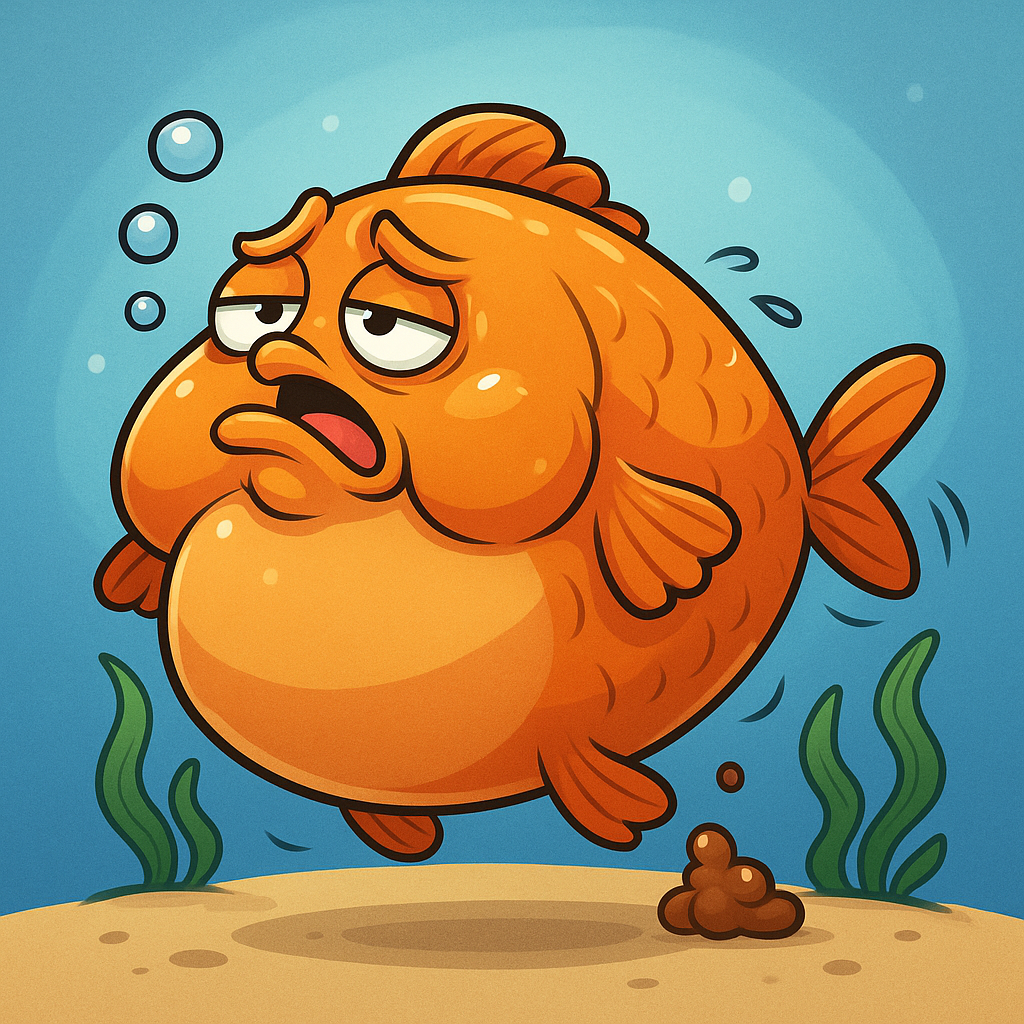Can I overfeed my fish?
🍽️ Overfeeding: Detailed Prevention & Fixes
🧠 Why Overfeeding Hurts
- 💥 Ammonia surge: Extra food → more fish waste + rotting leftovers → ammonia.
- 🌫️ Bacterial blooms: Heterotrophs explode, cloud water, eat oxygen.
- 🧱 pH crash risk: Nitrification consumes KH, so chronic overfeeding can drive pH down.
- 🦠 Pathogens thrive: Dirty substrates = fin rot, bloat, HLLE more likely.
- 🧪 Nitrate creep: Even if NH₃/NO₂⁻ stay 0, nitrates climb fast → chronic stress.
⚗️ Real-world math (why “just one extra pinch” matters)
- If you drop 1 g of 40%-protein dry food:
- That’s ~0.4 g protein; protein is ~16% nitrogen → 0.064 g N.
- ~60% of dietary N is excreted → ~38 mg ammonia-N enters the system.
- In 100 gal (378 L) that’s ~0.10 ppm NH₃-N (≈ 0.12 ppm total ammonia).
- That exceeds the comfort zone (NH₃ should be <0.02–0.05 ppm), especially at high pH/temp.
🎯 How Much to Feed (with grams you can weigh)
Aim for satiation without leftovers and let test results confirm you’re on track.
- 🐣 Fry / tiny juveniles: 5–10% body weight/day split into many micro-meals.
- 🐟 Growing juveniles: 2–4% BW/day in 2–3 meals.
- 🧓 Adults (community): 0.5–1.5% BW/day in 1 meal; add a fast day weekly.
- 🐊 Monsters/predators: ~1–2% BW every other day (or 3–4×/week).
- 🛸 Stingrays: 1–3% BW/day split small/frequent; watch waistline + nitrate.
🧮 Convert to pellets you can see
- ⚖️ Put 100 dry pellets on a kitchen scale → note grams → g/pellet.
- Example: 100 pellets = 5.0 g → 0.05 g each.
- If your Oscar (≈250 g) gets 1% BW/day = 2.5 g, that’s ~50 pellets.
- Fine-tune by observation (finish in 30–90 sec small fish; 3–5 min monsters).
🔁 Temperature rule: For every 3 °C (≈5–6 °F) drop, reduce portions ~20–30% (metabolism slows).
🧪 Use Tests to “Right-Size” Portions
- 📈 Nitrate delta check (weekly):
- If NO₃⁻ rises >10–20 ppm between your regular water changes, you’re likely overfeeding (or under-maintaining).
- 🧪 Surprise NH₃/NO₂⁻ in a cycled tank after feeding? Portion is too large or food is sinking into the substrate.
🚩 Clear Signs You’re Overfeeding
- 🌫️ Cloudy/milky water; surface film; musty smell
- 🧪 NH₃/NO₂⁻ detectable; NO₃⁻ rockets
- 🪱 Planaria/detritus worms; snail booms
- 🫨 Fish bloat, stringy pale poop; rays’ discs look “mushy”
- 🧼 Filters sludged days after cleaning
🛠️ If You Overfed (step-by-step)
- 🧻 Remove uneaten food (net/turkey baster).
- 💦 30–50% water change now; dechlorinate for chloramine if applicable.
- 💨 Max aeration; blooms consume oxygen.
- 🧪 Test NH₃/NO₂⁻/NO₃⁻ today + tomorrow.
- 🍽️ Fast 24 h (monsters: 24–48 h), then resume smaller portions.
- 🧱 If nitrite shows: prioritize water changes + oxygen; avoid salt with rays unless you absolutely must and at very low dose.
🧰 Techniques That Prevent Overfeeding
- 🎯 Target feed bottom dwellers with tongs/pipette; don’t broadcast “for everyone.”
- 🛟 Feeding ring for floaters—reduces waste into the overflow/HOB.
- ⏲️ Auto-feeder: Start under your manual amount; watch for a week; adjust.
- 🧊 Rinse frozen foods (mysis/shrimp) in a net to dump phosphate-rich juices.
- 🥒 Veg for plecos (zucchini, cucumber, squash): thin coins, night-feed, remove in 8–12 h.
- 🧽 Vacuum “feeding lanes” where food collects; don’t let it rot in dead spots.
- 🌪️ Flow audit: Ensure gentle current keeps food suspended long enough for fish to grab it, not shoot into filters.
🔎 Reading Poop (useful diagnostics)
- 🟤 Firm brown after pellets/seafood = normal.
- 🪵 Long brown strings in plecos grazing driftwood/biofilm = common; they are getting nutrition from what’s on the wood.
- 🧵 Pale/translucent strings = underfeeding, stress, or internal issues; reassess diet and water quality.
- 🧯 White, bubbly, mucous-like = possible parasites or bacterial imbalance—test water, then consider treatment.
🍽️ Food Type Pitfalls
- 🧴 Dry vs. frozen: Frozen is mostly water—don’t equate a 5 g frozen cube with 5 g dry pellets.
- 🧊 Thaw safely (fridge or cold water); never refreeze.
- 🦐 Shellfish pieces: nutrient-dense—feed smaller amounts than you think.
- 🐟 Avoid feeder fish: parasites, thiaminase issues, messy waste profile.
🧩 Species-Specific Notes
- 🐠 Community fish: Tiny meals once daily; weekly fast day.
- 🎨 African cichlids: Multiple small high-quality feeds; they beg—don’t cave.
- 🐊 Arowana/peacock bass/catfish: 3–5 min to satiation every other day; skip a day after heavy feed.
- 🛸 Stingrays: Small, frequent; watch disc thickness and nitrate trend—reduce grams first, not frequency.
- 🪵 Plecos: Night feeds; veg + quality wafers; wood for biofilm/enrichment; remove leftovers by morning.
- 👑 Discus: Several small clean feeds; vacuum leftovers; tight nitrate control (<20 ppm).
🧯 Myths to Drop
- ❌ “If they’re begging, they’re hungry.” (They’re opportunists.)
- ❌ “Herbivores can’t be overfed.” (They still foul water and can bloat.)
- ❌ “More food = faster growth without downside.” (Growth hit by poor water quality.)
🧾 Simple Weekly Routine (works!)
- 📆 Mon–Sat: Feed planned grams; spot-vac leftovers.
- 🧪 Wed: Quick NH₃/NO₂⁻ check (established tanks).
- 🧪 Sat: Nitrate check; if weekly rise >10–20 ppm, cut portions 10–20% or increase maintenance.
- 🌊 Sun: 30–50% water change; rinse filter media in tank water only.

Powered by Lightspeed
Display prices in:USD